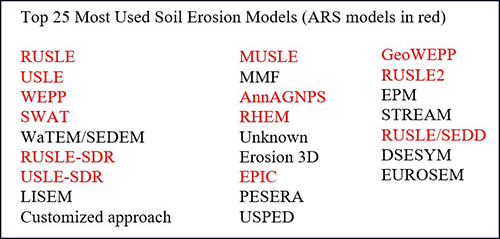ARS Scientists Are Developers of Most Used Prediction Technologies to Reduce Soil Loss
Contact: Kim Kaplan
Email: Kim.Kaplan@usda.gov
May 25, 2021
Agricultural Research Service scientists designed seven of the top ten—13 of the top 25—most used predictive technologies/simulation models that are reducing the loss of soil to erosion around the world, according to a recently published study.
Although originally developed for cutting down soil losses due to erosion from agricultural practices, today these models also are reducing soil loss from erosion on construction sites, mined land, road corridors, logging and clear-cut areas, landfills, even military training grounds and more in at least 126 countries.
Soil erosion by water has been estimated to annually cost about $8 billion to the global gross domestic product and reduce global agri-food production by 33.7 million tons with accompanying rises in world agri-food prices of up to 3.5 percent, according to a 2019 study. Further, some agronomists hold that soil erosion can unlock and increase carbon dioxide emissions.
Prediction technologies allow researchers, regulators and land managers to model how changes in various practices will affect the amount of soil that will be lost to erosion, at scales ranging from a single hillslope to whole watersheds. They can compare the likely benefits of applying different soil conservation practices.

Number two on the list of most used erosion prediction models is the progenitor of them all: the Universal Soil Loss Equation (USLE), which ARS first published as a complete technology in 1965. USLE began as a fairly simple equation that gave an answer in tons of soil lost per acre per year by multiplying a few direct factors representing rainfall, soil type, cropping system, conservation practices and hillslope steepness and length.
Experts have hailed the USLE as the most significant development in soil and water conservation in the 20th century.
Number one on the list—the single most applied soil erosion model in the world—is an outgrowth of USLE, published by ARS as the Revised Universal Soil Loss Equation (RUSLE) in 1997. RUSLE was adapted for sophisticated computer interfaces including graphics, as well as given new weighting of some factors that made the model independent of land-use. This broadened RUSLE’s applicability.
RUSLE has been revised several times since that first publication, each time adding new capabilities. For example, RUSLE2 treats land use as a continuum taking into account that previous use affects erosion under a new use. Other factors like the type of vegetative cover—crop, pasture, woodland, bare ground—also were added making the simulation more accurate.
 ARS scientists are the designers of seven of the top ten most used computer simulation models that are helping reduce soil erosion around the world.
ARS scientists are the designers of seven of the top ten most used computer simulation models that are helping reduce soil erosion around the world.
In the wake of these two big picture models—USLE and RUSLE—ARS researchers have developed specialized models, each meant to provide greater detail in a particular area of controlling erosion. The ARS Water Erosion Prediction Project (WEPP) model was designed to provide more reliable modelling of waterflow and sedimentation movement in small water channels all the way up to giant watersheds.
Other models/predictive technologies on the list focus on predicting the impact of land management practices on water, sediment and agricultural chemicals in large complex watersheds such as the Soil Water Assessment Tool (SWAT), predicting the relationship between soil erosion and soil productivity such as the Erosion Productivity and Impact Calculator (EPIC) and predicting runoff and erosion rates on rangelands using Range Land Hydrology Models (RHEM).
The goal of all the models that ARS scientists develop and continue to refine is to help preserve one of the most valuable resources there is: productive soil, for which there is no replacement.
The study, published in Science of the Total Environment, was conducted by 67 soil erosion scientists from 25 countries.
The Agricultural Research Service is the U.S. Department of Agriculture's chief scientific in-house research agency. Daily, ARS focuses on solutions to agricultural problems affecting America. Each dollar invested in agricultural research results in $17 of economic impact.
